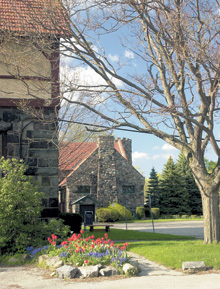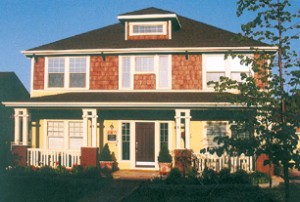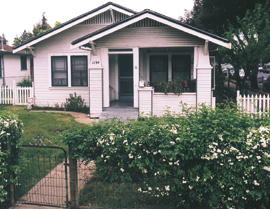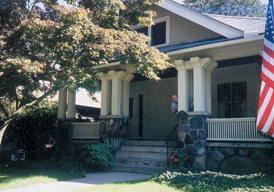by John Luke

The Roycroft Blacksmith and Copper Shop, a much-beloved 1902 building on the Roycroft Campus in East Aurora, N.Y., known for the past half century as the Roycroft Shops, closed early on April 27, 2005, its final day of operation. When it reopens, restored and renovated under new ownership sometime late next year, it will be the first of a planned series of historic restorations aimed at bringing what was once one of America’s most vibrant Arts and Crafts venues back to life.
 Two days later, the nonprofit Roycroft Campus Corporation (RCC) took possession of the building and began what is expected to be a multiyear, multimillion-dollar campaign to restore it and four other principal Roycroft Campus buildings. They plan to revitalize the site as a working community of artisans, much as it was under the leadership of its founder, Elbert Hubbard, in its heyday during the first two decades of the 20th century.
Two days later, the nonprofit Roycroft Campus Corporation (RCC) took possession of the building and began what is expected to be a multiyear, multimillion-dollar campaign to restore it and four other principal Roycroft Campus buildings. They plan to revitalize the site as a working community of artisans, much as it was under the leadership of its founder, Elbert Hubbard, in its heyday during the first two decades of the 20th century.
News of the planned restoration effort first appeared in January 2005, when Douglas G. Swift, president of the RCC, announced plans for the purchase of the Copper Shop as the first step in buying and restoring the buildings in the block bordered by Main and Grove Streets in East Aurora. Swift, a pleasant-spoken architect and developer, is no stranger to historic preservation. He recently drew approval for the tasteful and historically sensitive work he and his firm did in renovating a warehouse that had been part of the Larkin Soap Company complex, a sensitivity he perhaps comes by naturally: his middle initial stands for “Gamble,” and he is a grandson of David B. and Mary Gamble, for whom Charles and Henry Greene designed the Gamble House in Pasadena.
 With the quarter-century-old American Arts and Crafts revival drawing throngs of visitors to auctions and shows across the country, and while New Urbanists embrace Craftsman architecture and historic bungalow neighborhoods turn from dust to gold, many observers believe a revived and revitalized Roycroft in the historically rich Buffalo Niagara region in western New York State could become a new year-round national center for Arts and Crafts education, exploration and celebration.
With the quarter-century-old American Arts and Crafts revival drawing throngs of visitors to auctions and shows across the country, and while New Urbanists embrace Craftsman architecture and historic bungalow neighborhoods turn from dust to gold, many observers believe a revived and revitalized Roycroft in the historically rich Buffalo Niagara region in western New York State could become a new year-round national center for Arts and Crafts education, exploration and celebration.
As the Buffalo News reported the day after the RCC announcement, proponents of heritage tourism in the area have long pointed to the Campus as a potentially central component on a tourism trail that may one day lead visitors to the region’s historical and architectural treasures. A restored “living campus” at Roycroft, with printers, furniture makers, metalworkers, ceramicists, painters and other artists working and perhaps living on site, would complement the more museum-like attractions in a region whose residents and civic and business leaders have embraced historic preservation in a significant way over the past quarter century.
 Ted Pietrzak, executive director of the Burchfield-Penney Art Center at Buffalo State College and head of the Buffalo Niagara Convention and Visitors Bureau cultural tourism committee, told Buffalo News reporter Tom Buckham that packaging such gems “is like building a house; the Roycroft is a section of that house.
Ted Pietrzak, executive director of the Burchfield-Penney Art Center at Buffalo State College and head of the Buffalo Niagara Convention and Visitors Bureau cultural tourism committee, told Buffalo News reporter Tom Buckham that packaging such gems “is like building a house; the Roycroft is a section of that house.
There is a fair amount of enthusiasm for this in the community, especially among artisans who carry on the Arts and Crafts tradition and would love to come back to the place where it all began.”
For Kitty Turgeon, who bought the Copper Shop in 1976 and has owned six other buildings on the Campus over the past 34 years, and who led a successful effort to have the Campus designated a National Historic Landmark in 1986, the shop’s closing was a piquant moment. “I look at it this way,” she said. “I’m marrying off another daughter. I’ll just be a good mother-in-law and keep my mouth shut, like the Queen Mum.”
The Roycroft flourished through the first decade and a half of the 20th century. Roycroft artisans produced high-quality products in the Arts and Crafts style that sold for what would today be premium prices. The beginning of the end came in 1915, when Hubbard and his wife perished aboard the cruise ship Lusitania after it was torpedoed by a German U-boat off the coast of Ireland en route to Europe. The Roycroft enterprise continued to sell its publications, furniture and other works for more than two decades, but it gradually lost steam as the Arts and Crafts style went out of fashion and the Great Depression took hold of the country.
The Roycroft facilities were sold in 1939 and have remained in various private hands since then. Most have survived, but not all: over the last two decades, fire reduced one building, the Power House, almost to a ruin; large portions of two more were lost, and historic features of other buildings have been removed or compromised.
Only one, the Roycroft Inn, has experienced a major restoration. But the success of that effort, through the combined efforts of committed individuals and at least one important foundation, appears to have energized a new young generation of historic preservationists and Arts and Crafts believers.
First Moves Toward Restoration
 In addition to Turgeon, whose family bought the bankrupt Roycroft Inn in 1971 and who, as noted earlier, has bought and sold several of the other properties, lifelong Roycroft collector Boice Lydell now owns four properties, including the “Bungle House,” which he has reinvented as the Roycroft Arts Museum (see Issue No. 44, “The Museum in the ‘Bungle-House’”). For many years, theirs have been articulate and forceful voices advocating preservation of the Roycroft campus and proper restoration of as many of its historic structures as possible.
In addition to Turgeon, whose family bought the bankrupt Roycroft Inn in 1971 and who, as noted earlier, has bought and sold several of the other properties, lifelong Roycroft collector Boice Lydell now owns four properties, including the “Bungle House,” which he has reinvented as the Roycroft Arts Museum (see Issue No. 44, “The Museum in the ‘Bungle-House’”). For many years, theirs have been articulate and forceful voices advocating preservation of the Roycroft campus and proper restoration of as many of its historic structures as possible.
Turgeon succeeded in taking the first tangible step when she managed to get the campus designated a historic landmark in 1986. Two years later, business leaders formed a group to explore the possibility of restoring the Inn, which the Turgeon family had closed after trying unsuccessfully to make it profitable. In 1989, that group organized itself as the Roycroft Revitalization Corporation (RRC), pledging to save the Inn and market it to developers nationwide. More than $1.5 million was raised for restoration of much of the Inn’s exterior.
In late 1993, The Margaret L. Wendt Foundation of Buffalo came into the picture. Together, the RRC and the Wendt Foundation proposed to develop a 22-suite, four-star country inn and restaurant. More than $8 million was spent on the restoration, and The Roycroft Inn reopened its doors in June 1995. The 10-year anniversary of the reopening was celebrated this past June (see Issue No. 45, “American Bungalow News,” page 141).
Meanwhile, despite isolated preservation efforts by some owners, other buildings on the Campus continued to deteriorate. By late 1993, when the threat to the historic integrity of the site as a whole began to be seen as real and imminent, the prospect of undertaking active restoration of the entire Campus took shape and was broached at the RRC’s annual meeting in January 2004. Discussion continued through that spring and in April a resolution to proceed was adopted. Ten new board members with diverse skills helped define the vision — “The Roycroft Campus: as if Elbert Hubbard and the Roycrofters never left” — and the group changed its name to Roycroft Campus Corporation to better reflect the new mission.
Ambitious New Plans
After sparking the successful effort to rehabilitate the Inn, the group now plans to acquire and restore much of the remainder of the Campus, with preliminary cost estimates of approximately $50 million. RCC president Doug Swift says that the ultimate goal is not just to preserve the unique architectural setting of the Campus but to bring the Roycroft community and Hubbard’s ideals back to life by reintroducing working artisans on the campus, developing interpretative educational programming and encouraging the development of a center for creativity and innovation in the decorative arts, fine arts and literature.
 With restoration of the Copper Shop now underway, the RCC is looking to buy four other major structures: the Chapel, built in 1899 as a meeting hall and now owned by the adjacent town of Aurora, which uses it as its Town Hall; the Print Shop, completed in 1901 to meet demand for Hubbard’s best-selling A Message to Garcia and now occupied by the Cornell Cooperative Extension; the Furniture Shop and Bindery, owned and operated by Onda Dylewski as the Roycroft Antique Center, which houses the Roycroft Master Artisans and the Roycrofters at-Large Association; and the Power House, which was heavily damaged by fire eight years ago.
With restoration of the Copper Shop now underway, the RCC is looking to buy four other major structures: the Chapel, built in 1899 as a meeting hall and now owned by the adjacent town of Aurora, which uses it as its Town Hall; the Print Shop, completed in 1901 to meet demand for Hubbard’s best-selling A Message to Garcia and now occupied by the Cornell Cooperative Extension; the Furniture Shop and Bindery, owned and operated by Onda Dylewski as the Roycroft Antique Center, which houses the Roycroft Master Artisans and the Roycrofters at-Large Association; and the Power House, which was heavily damaged by fire eight years ago.
As the first building to be restored, the Copper Shop will serve multiple purposes as a visitor center and artisan workshop, gift shop, exhibit space and office while the remainder of the Campus is restored. RCC executive director Christine Peters says the long-term plan for the building is to reestablish it as a working metalsmith shop and copper-works museum.
“This is an opportune time to start attempting to acquire the Roycroft buildings,” Peters says. “Many of the owners are looking for other sites.” The town of Aurora wants to relocate its Town Hall and the Wendt Foundation is under contract to purchase the Chapel. The Cornell Cooperative Extension’s mission has changed, and Cornell University has now put the Print Shop on the market for $1 million.
 The immediate future of the Furniture Shop/Bindery building and the Power House is less certain. “Right now we’ve got our hands full with the Copper Shop,” Swift says. “Money is tight, as it always is, and we’re not committing to deadlines, but we have a lot of people with a lot of great ideas and we’re optimistic we can have it fully restored by the end of next year. It will be a microcosm of the larger restoration effort and will be the place where we begin the educational programming that Kitty Turgeon will oversee as Education Director.”
The immediate future of the Furniture Shop/Bindery building and the Power House is less certain. “Right now we’ve got our hands full with the Copper Shop,” Swift says. “Money is tight, as it always is, and we’re not committing to deadlines, but we have a lot of people with a lot of great ideas and we’re optimistic we can have it fully restored by the end of next year. It will be a microcosm of the larger restoration effort and will be the place where we begin the educational programming that Kitty Turgeon will oversee as Education Director.”
For his part, Boice Lydell, who is serving as the RCC board’s co-chair for restoration and planning, has long advocated that all of the Roycroft buildings be owned by a single nonprofit entity and be integrated into a living-working museum, “maybe even with workers dressing in the period.
“People want to see the original works and they want to be able to see how and where they were made,” he says, adding that he believes a truly comprehensive Campus restoration should encompass not just all of the extant buildings, but the landscaping that originally surrounded them, which today is mostly parking lots. “It’s an extremely large and difficult project,” he says. “Craftsman Farms was just one building. Here we have potentially more than a dozen.” A legendary Roycroft collector, Lydell owns scores of artifacts he would like to see placed back into properly restored buildings: furniture, lamps, printing presses and other equipment, including the lumber-mill saws that were used to cut the buildings’ original timbers.
A Historic Region Reawakening
Patrick J. Mahoney, a Buffalo architect who has been deeply involved in historic preservation efforts in the region for many years, says that in the short term the challenge of restoring the buildings the RCC has so far targeted “is not so hard. But in the long term, it could be very large. Can they ultimately restore all of the buildings? Probably not. But we’ve been surprised by many things that have happened around Buffalo.”
 Mahoney calls the demolition of Wright’s Larkin Building in 1950, “one of the major losses on this continent,” and says it reflected an attitude of negligence toward historic buildings that was pervasive in the region up until the early 1980s. Today, he says, it is “inconceivable” that anyone could get away with tearing down a structure of any potential historic significance and that historic preservation is now seen as an integral part of cultural tourism and the region’s future economic health.
Mahoney calls the demolition of Wright’s Larkin Building in 1950, “one of the major losses on this continent,” and says it reflected an attitude of negligence toward historic buildings that was pervasive in the region up until the early 1980s. Today, he says, it is “inconceivable” that anyone could get away with tearing down a structure of any potential historic significance and that historic preservation is now seen as an integral part of cultural tourism and the region’s future economic health.
“A lot of credit has to go to leaders in the business community, who have really challenged the way Buffalo has thought in the past and changed the way it thinks today. Many of us thought restoring the Darwin Martin main house would be a major achievement. Today the entire complex has been embraced.
 “The people working on Roycroft are people who can and could make it happen there, too,” he says.
“The people working on Roycroft are people who can and could make it happen there, too,” he says.
In an assessment of Hubbard and the Roycroft, Brown University architectural historian Jack Quinan wrote, “The legacy of Elbert Hubbard’s Roycroft is twofold. Hubbard did raise the intellectual consciousness of Americans a notch, especially in the areas of literature and fine printing. But his principal legacy … is the idea of Roycroft, the creation of the community and the transformation of the village of East Aurora into a center, however brief its existence, of real intellectual ferment.
“While East Aurora today retains the physical legacy of the Roycroft community and has struggled heroically with the restoration of the Roycroft Inn, it has not yet realized the value and potential of the Roycroft, not only as a historic landmark site but also as a place where Elbert Hubbard’s belief in the free exchange of ideas through intellectual discourse could flourish once again.”
It’s that presence, and the potential to flourish anew, that make the restoration campaign a bold and immensely hopeful venture that the entire American Arts and Crafts community can embrace.
Vintage Images Courtesy Boice Lydell
 Vallejo, Calif., Brian Johnson
Vallejo, Calif., Brian Johnson Boise, Idaho, Tom and Angie Beauchaine
Boise, Idaho, Tom and Angie Beauchaine Provo, Utah, Kurt and Viktoria Anderson
Provo, Utah, Kurt and Viktoria Anderson Santa Clara, Calif., Dan and Joan Meacham
Santa Clara, Calif., Dan and Joan Meacham Geneva, N.Y., Bob and Ann O’Connor
Geneva, N.Y., Bob and Ann O’Connor Milan, Mich., Steve and Sue Okonski
Milan, Mich., Steve and Sue Okonski Madison, Fla., Stephen and Rae Pike
Madison, Fla., Stephen and Rae Pike









Recent Comments